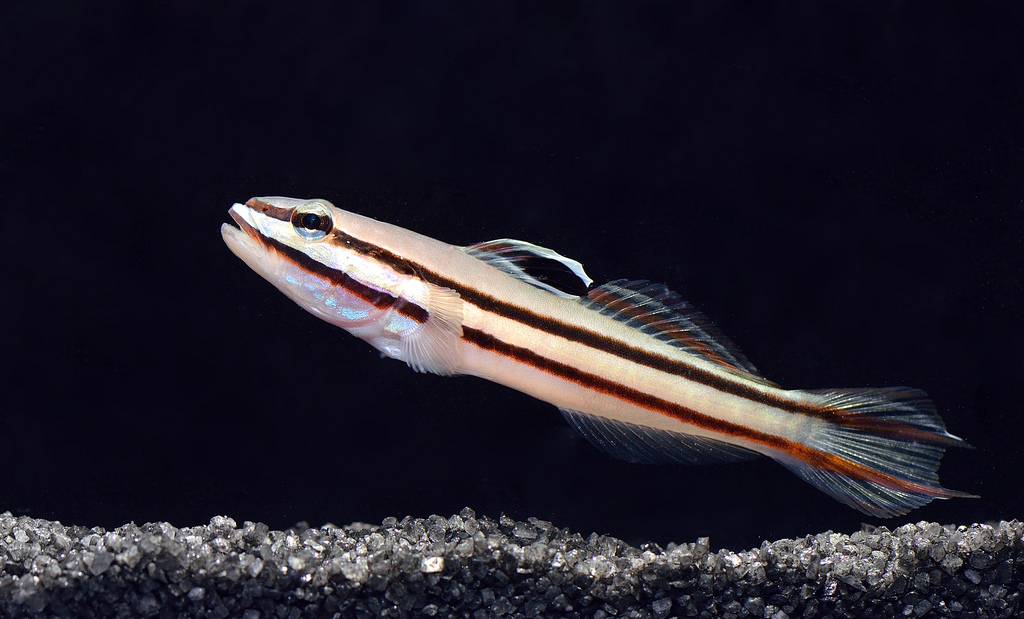Chances of bumping into cool fish increases exponentially when you’re out and about marauding the various Balinese wholesale facilities. Picking out a truly rare gem amidst a swathing plague of reef fish requires a keen eye and an innate intuition. That being said, there an equally abundant amount of regular fanfare that are just as deserving of a second look, and Valenciennea helsdingenii fits the bill just right.

The gobiine genus Valenciennea houses about 15 members, although this number is set to increase with the future additions of a few currently known but undescribed species. The genus boasts of medium sized, elongated gobies with the convergent ability of sand sifting. With the exception of V. bella, all species feature a white to ecru ground color, decorated either with spots or lines depending on the individual species.
Of the handful of species available to the hobbyist, Valenciennea hesldingenii is without a doubt one of the more colorful and visually appealing of the lot. While this species cannot be considered rare, it is never common and is seldom offered in any significant quantity.

In this contemporary and edgy species, the ground color ranges from talc to ecru, and is uniformly shaded throughout. The cheek is spotted in reflective cerulean, and occasionally in yellow. The most defining and diagnostic characteristic for this species is the presence of a pair of parallel stripes running horizontally across its length. Both stripes are wine red to bordeaux, and the uppermost stripe starts at the base of the upper lip, through the eye, horizontally lengthways and ending at the edge of the caudal fin. The ventral stripe starts just below, at the base of the upper lip, and travels parallel to the the caudal fin edge as well. The two stripes extrapolate outside of the caudal fin margin to form filamentous extensions, a trait which is unique to this species.
As with all gobies, the dorsal fin is split, and in this species, no membranous connections are present between the two. The first dorsal fin is black, outlined in white on the base and outer edge. The second dorsal fin is hyaline with a suffused stripe in bordeaux.

As with all Valenciennea species, V. helsdingenii is no exception when it comes to sand sifting. In suitable conditions, this species, like the rest, is capable of fervently sifting large amounts of sand in a relatively short amount of time, up to 260 mouthfuls in a 10 minute window. Their large expandable jaws first siphon a mouthful of sand, from which edible morsels are meticulously and judiciously filtered out. Everything else passes through the gills and out back into the environment. Due to their hovering nature, the act of sand sifting may create a mess in small aquariums, especially those with corals festooned on the sand bed.
V. helsdingenii is uncommon in the wild, and this translates to its availability in the trade as well. The species is most often seen in deepwater, at depths of 30-50m (100-160ft) in pairs over sandy terrain in which they build their burrows. Each burrow can reach up to 60cm in length, and is often stabilized extensively with rubble. The gobies take turns in engineering their home and ensuring it is structurally sound. In doing so, they may use up to 5000 pieces of individual coral rubble.

Valenciennea helsdingenii ranges from the Marquesan Islands, Japan, the Philippines, Indonesia, New Britain, the Solomon Islands, the Great Barrier Reef and New South Wales, Australia, Saudi Arabia, Maldives, Seychelles, and southern Africa. In 2012, the species was recorded in Punnakayal coast off the southeast coast of India for the first time, and this subsequently served as an added range extension into the Indian Ocean. In the aquarium trade, this species is available from Philippines and Indonesian imports, although it can hardly be considered common.
If you’re jaded with the ubiquitous V. pulleris, and are hard pressed in finding the gorgeous V. bella, V. helsdingenii may prove to be an unusual and unorthodox substitute for you and your sand sifting needs.



